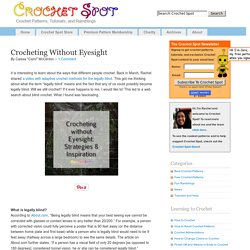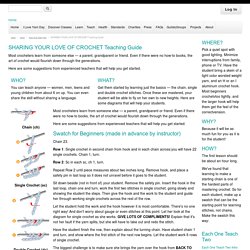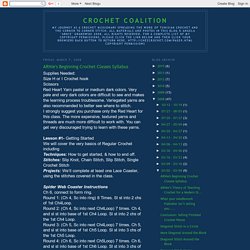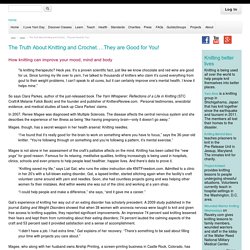

Crocheting Without Eyesight. It is interesting to learn about the ways that different people crochet.

Back in March, Rachel shared a video with adaptive crochet methods for the legally blind. This got me thinking about what the term “legally blind” means and the fact that any of us could possibly become legally blind. Will we still crochet? If it ever happens to me, I would like to! This led to a web search about blind crochet. What is legally blind? Learning to Crochet Blind Yet whether a person is fully sighted, is completely without sight, or lies anywhere in between, he or she can still crochet.
I found a very informative thread on Crochetville.com that spoke about teaching crochet to a person that is blind. “I would first make a foundation chain for her and then let her feel it. The following tip could be helpful for any crocheter, but worked well for the commenter. And finally, the commenter shared tips on finding patterns. So what about you, my friends? Creating Beautiful Things in Life: How to properly size crochet hats. Chart for correct sizing, including Magic Circle Sizes.
41K+Crocheting hats is something I know well.

In my experience, getting the hat to fit properly without a model is not always easy. Most Beanies start of with a flat circle. The size of the circle depends upon the circumference of the head. Looking on the Internet I have found several Blogs that offered a chart to help in getting the proper size. The measurements for the circumference of the head and the corresponding sizing for the flat circle and hat height varied somewhat.
SHARING YOUR LOVE OF CROCHET Teaching Guide. Most crocheters learn from someone else — a parent, grandparent or friend.

Even if there were no how-to books, the art of crochet would flourish down through the generations. Here are some suggestions from experienced teachers that will help you get started. You can teach anyone — women, men, teens and young children from about 6 on up. You can even share the skill without sharing a language. Get them started by learning just the basics — the chain, single and double crochet stitches.
Chain (ch) Single Crochet (sc) Double Crochet (dc) Chain 23. Row 1: Single crochet in second chain from hook and in each chain across:you will have 22 single crochets. Row 2: Sc in each sc, ch 1, turn. Repeat Row 2 until piece measures about two inches long. Sit down beside (not in front of) your student. Let the student hold the work and the hook however it is most comfortable. Crochet Coalition: ARNie's Beginning Crochet Classes Syllabus. Supplies Needed:Size H or I Crochet hookScissorsRed Heart Yarn pastel or medium dark colors.

Very pale and very dark colors are difficult to see and makes the learning process troublesome. Variegated yarns are also recommended to better see where to stitch.I strongly suggest you purchase only the Red Heart for this class. The more expensive, textured yarns and threads are much more difficult to work with. You can get very discouraged trying to learn with these yarns.Lesson #1- Getting StartedWe will cover the very basics of Regular Crochet includingTechniques: How to get started, & how to end off.Stitches: Slip Knot, Chain Stitch, Slip Stitch, Single Crochet StitchProjects: We’ll complete at least one Lace Coaster, using the stitches covered in the class.
Spider Web Coaster InstructionsCh 6, connect to form ring.Round 1: (Ch 4, Sc into ring) 8 Times. The Truth About Knitting and Crochet….They are Good for You! How knitting can improve your mood, mind and body "Is knitting therapeutic?

Heck yes. It’s a proven scientific fact, just like we know chocolate and red wine are good for us. Since turning my life over to yarn, I’ve talked to thousands of knitters who claim it’s cured everything from gout to their weight problems. I can’t speak to all cures, but it can certainly improve one’s mental health. So says Clara Parkes, author of the just-released book The Yarn Whisperer: Reflections of a Life in Knitting (STC Craft/A Melanie Falick Book) and the founder and publisher of KnittersReview.com. In 2007, Renee Magee was diagnosed with Multiple Sclerosis.
Magee, though, has a secret weapon in her health arsenal: Knitting needles. “I’ve found that it’s really good for the brain to work on something where you have to focus,” says the 36-year-old knitter. Magee is not alone in her assessment of the craft’s palliative affects on the mind. “I didn’t have a job. Cast on, calm down Use it or lose it.